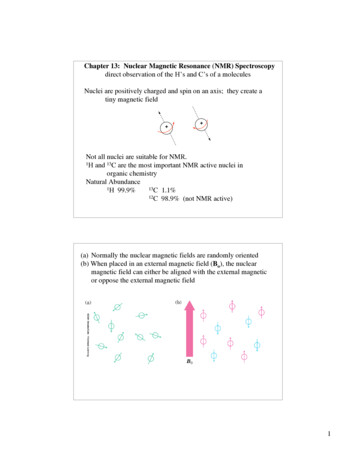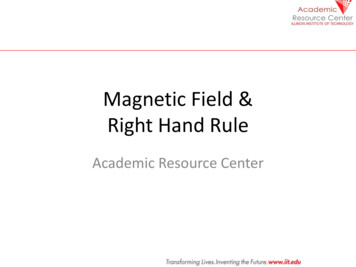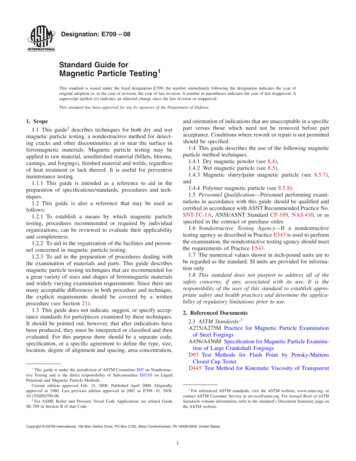
Transcription
1MAGNETICFIELD THERAPYFOR PAIN
MAGNETIC FIELD THERAPY FOR PAINWhile pain affects millions of Americans every year - 1 in 4 at any given time, optionsfor safe, effective pain management are lacking in general. This leaves thosesuffering from acute, chronic, and recurrent pain relying mostly on nonsteroidalanti-inflammatory drugs (NSAIDs), which increase risk of potentially fatal gastriclesions, and narcotics, which pose risk of drug dependency.THE PAIN AFFECTS 1 IN 4AMERICANS EVERY YEARPILLS INCREASE RISK OF POTENTIALLYFATAL GASTRIC LESIONSUsually, multiple concurrent treatments are required to treat chronic pain. It is rarethat a single medication or treatment provides total relief for the patient sufferingfrom recurrent or long-term pain. For this reason, more and more primary careproviders are referring their patients to complementary and alternative medicine(CAM) clinics and providers to complement the treatment they’re able to provide(Institute of Medicine).Today, there are more visits paid out of pocket to alternative medical providersthan there are to primary care providers.2
3MAGNETIC FIELD THERAPY FOR PAINALTERNATIVES FOR PAIN MANAGEMENTAcupunctureHerbsSupplementsMassage therapyChiropractic adjustmentsPulsed electromagneticfields (PEMFs)In addition to the treatment received from theirprimary care physician (like narcotics, prescriptionNSAIDs, and physical therapy), many patients arereceiving alternative treatment concurrently to improveoutcomes. These alternative treatments includeacupuncture, herbs and supplements, massage therapy,chiropractic adjustments, and pulsed electromagneticfields (PEMFs). It’s rare that a patient with chronic orrecurrent pain will find relief with just a single technique.PERMANENT MAGNETS FOR PAIN RELIEFAlthough this report will focus primarily on the benefitsof PEMFs in pain management, it’s also important to notethat static magnetic fields from permanent magnets mayprovide benefits too. PEMFs are better researched. Whileresearch differs in conclusions on the best methods andapplications, static magnetic fields might be helpful inalleviating chronic pain in the superficial layers of the body,especially when paired with other kinds of treatments.
4PEMFS AND PAIN MANAGEMENTMagnetic fields that are dynamic or pulsed, createdby specifically designed electronic equipment, arecalled pulsed or frequency electromagnetic fields,or PEMFs for short. PEMFs have been used for painmanagement and treatment of many other healthconditions in Eastern Europe for decades. Muchresearch has been done on the benefit of PEMFsin treating acute, chronic, and recurring pain inpatients with musculoskeletal and other disorders.NO PEMFSPEMFs have a direct effect on pain receptors,in some cases equivalent to the benefit ofabout 10 mg of morphine.But the real, more valuable, safer, and longerlasting improvement in pain most often happensbecause of the healing effects of the causes of thepain.NO PEMFSWITH PEMFSWITH PEMFSWITH PEMFS
5For example, PEMFs have been found to:REDUCE TISSUE SWELLING FROM INJURYOR INFLAMMATIONREVERSE CHRONIC INFLAMMATIONPOTENTIAL MECHANISMS OF MAGNETICFIELD EFFECTS ON PAINPain is the result of damage to cells, but it’s much morecomplex than that. Cell injury leads to a myriad ofmechanisms that contribute to the development of pain,including:IMPROVE CIRCULATIONEdema (swelling)SPEED TISSUE REPAIRPoor blood supply; poor blood flowINCREASE ENERGY IN THE TISSUETissue or cell deathREDUCE MUSCLE SPASMPoor energy productionInability to repair itselfImproving these aspects of the causes of anypain leads to a reduction or alleviation ofpain in any person.
6PEMFs reduce the experience of pain by workingto stop and reverse these mechanisms and helpthe body to repair underlying damage.PEMFs can raise the pain threshold, increase circulationto the tissue, stimulate the production of importantpeptides, and provide other benefits, all to improve thecell’s ability to repair itself and reduce and prevent pain.PEMFs are effective in treating a myriad of chronic painconditions, including:Back painOrthopedic ormusculoskeletal painFibromyalgiaOsteoarthritis painHeadachePelvic pain syndromeMigrainePostoperative painNeuropathyShoulder pain
7BACK PAINUp to 85% of adults will experience back pain at some pointin their lives. Up to 10% of those who develop lower backpain still have the pain 3 months after it starts, making it achronic condition. Back pain is the second most commonneurologic condition, second only to headaches.85%10%85% OF ADULTS WILL EXPERIENCE BACK10% STILL HAVE THE PAINPAIN AT SOME POINT IN THEIR LIVES.3 MONTHS AFTER IT STARTS.A large variety of conditions leads to back pain, includingdisc disorders, sciatica, arthritis, whiplash, and otherskeletal irregularities. There are many treatmentapproaches to back pain with variable degrees ofsuccess. Most people want to avoid injections, narcotics,and surgery if possible. PEMFs have been found to beextraordinarily safe and effective for back pain.Lumbar disc prolapse with radiculopathy (nervecompression, commonly known as sciatica) isparticularly disabling. Radiculopathy causesdamage to the nerves coming from the lower spinethat can be permanent if not treated successfullyand early.Two randomized studies looked at people witheither nerve compression or whiplash.
8PEMFs were used twice aday for 2 weeks For nerve compression, the average time to pain reliefand painless walking was 8 days in the PEMF group and12 days in controls In the people with whiplash: 50% reduction in head pain. 70% reduction in neck pain. 67% reduction in shoulder/arm pain. The results would be expected to be even better withhigher intensity PEMFs over a longer period. (Thuile)50%70%67%
9PAINPEMFs have also been shown to increase cellular repairin the spinal discs, meaning that PEMFs can be used notonly to help heal damaged discs but may also be usefulfor preventing the breakdown of discs leading to lumbardisc disease. (Lee)The 2 groups were compared for pain levels, adisability score, and an objective sensory nervefunction testDISABILITYIMPROVEMENTIn another study, 20 people were treated with mediumintensity PEMFs of varying frequencies 20 minutes aday for 3 weeks and compared to a placebo group.Both groups also received standard medical care. The 2groups were compared for pain levels, a disability score,and an objective sensory nerve function test. The painlevel decreased by about half with PEMFs and only 17%with standard care. The disability level improved by 56%with PEMFs and 35% with only standard care. The PEMFgroup also had much better improvement in personalcare, lifting, walking, sitting, standing, sleeping, social life,and ability to work. The PEMFs not only improved painsymptoms and function but also promoted repair andreversal of the nerve damage. (Omar)20 PEOPLE WERE TREATED WITH MEDIUM-INTENSITY PEMFS OF VARYING FREQUENCIES20 MINUTES A DAY FOR 3 WEEKS AND COMPARED TO A PLACEBO GROUPPEMFS GROUPPLACEBO GROUP50%17%56%35%
10FIBROMYALGIAThe only officially approved treatment for fibromyalgiatoday, using medication, is not curative, has a wide rangeof side effects, and isn’t effective for everybody. However,evidence shows that PEMFs are helpful in reducing theunwanted symptoms of fibromyalgia in many cases.In one study, patients suffering from fibromyalgia slept ona mattress pad embedded with medium-intensity staticmagnets for 16 weeks. Those who slept on the placebo,a nonmagnetized pad, showed unremarkable decreasein pain (1%), change in physical functioning (3%), orimprovement in sleep (6%).However, those who slept on the magnetized mattresspad showed a significant decrease in total pain of12%, 30% improvement in physical functioning, and adecrease of 38% of average pain scores. Furthermore,those patients demonstrated a 37% improvement insleep. Higher intensity PEMFs, whether used at night orthrough the day, would be expected to produce evenbetter results. (Colbert)Patients suffering from fibromyalgia slept with medium-intensitystatic magnets for 16 weeksPEMFsPLACEBODecrease in pain12%1%Change in physical functioning30%3%Improvement in sleep37%6%
11In another study using PEMFs, 56 women received eithersham or active low-intensity PEMF for 30 minutes twicea day for 3 weeks. The PEMF group showed a 52%improvement in fibromyalgia scores versus 11% in thesham group and a 235% improvement in being able tofunction physically. About 64% of the active treatmentgroup rated themselves as clinically improved comparedto 21% of the sham treated individuals. In fact, the PEMFgroup felt significantly better than the sham group inbody pain, vitality, social functioning, and emotionaland mental health. Of the people who were treated withthe sham device, 53% rated themselves as worse at the endof the study. Two months after treatment ended, womenhad lost most of their treatment benefit. (Sutbeyaz)Shorter studies - 7 weeks, for example - tended to showless significant results. This again demonstrates thatPEMF therapy must often be continued over an extendedtime to be most effective and maintain benefit. Ideally,people with fibromyalgia should continue treatmentuntil the problem has resolved. How long this would takeis highly individual.PEMF GROUPImprovement in fibromyalgia52%Improvement in being able to functionphysically235%Body pain, vitality, social functioning, andemotional and mental healthsignificant improvement
12HEADACHEPEMFs have been found to be very helpful for headache.One study was done in people who failed treatment withacupuncture and medications. PEMF for 15 days reducedmigraine, tension, and cervical (neck) headaches,lasting for up to 1 month after treatment. They had atleast a 50% reduction in frequency or intensity of theheadaches and needed fewer painkillers. PEMF treatmentwas most effective for tension headaches, with 88% ofsufferers reporting excellent or good results. (Prusinski)Chronic migraine also responds to PEMFs. Mediumintensity PEMFs applied on days people were migrainefree resulted in significant decreases in the numberof attacks and the length of the episode. One suffererwas even symptom free for 1 year after treatment.PEMFs were not as effective during attacks, so the studyauthors concluded that these PEMFswould be very effectivepreventive treatment formigraine. (Giczi)MIGRAINEAnother study found thatmedium-intensity PEMFsapplied to the head dailyfor 10 to 15 minutes for30 days improved thefrequency and intensityof migraine attacksby 66%, compared to23% in the placebogroup. (Lazar)For migraine, PEMFs applied to specific acupuncture pointson the inner thighs for at least 2 weeks are effective shortterm therapy. (Sherman) Longer term treatment leads togreater reduction of headache activity. One month after atreatment course, 73% of patients reported decreasedheadache activity versus 50% for sham treatment.Another 2 weeks of treatment after the 1-month followup gave an additional 88% decrease in migraineactivity.
13NEUROPATHYPeripheral neuropathy causes serious chronic painmost commonly in the hands and feet, decreasingindependence and quality of life if left untreated. Becausethe causes of neuropathy vary significantly amongindividuals, identifying the most effective treatment - thatis, the treatment that addresses the underlying causesof the neuropathy - can be exceptionally difficult. Duringthis trial-and-error process of finding the most effectivetherapy, the person continues to suffer from severe nervepain, loss of mobility, and other debilitating symptoms.A number of studies have researched the effect ofPEMFs on people with peripheral neuropathy. Whentreatment lasted longer than a few weeks, theresults were similar across all studies: People with diabetic peripheral neuropathy whoreceived 2 hours of PEMF per day for 3 months inone study showed a significantly greater reductionin neuropathy symptoms and pain scores over theplacebo group. (Weintraub) People with more severe treatment-resistant carpaltunnel syndrome (CTS), another form of neuropathy,were administered PEMF over 10 months and showedbig improvement in pain and other symptoms as wellas improvement in nerve conduction tests. (Weintraub& Cole) People with complex regional pain syndrome (CRPS,one of the most severe and disabling forms ofneuropathy and generally regarded as having poortreatment outcomes with traditional medicine, showedimprovement in both pain and swelling in just 10 daysof PEMF treatment. (Saveriano)Several other studies have confirmed these outcomes.Results were more conflicting in short-term studieslasting just a few weeks or less. Some shorter studiesshowed improvement in pain and functioning; othersshowed no significant difference between the test groupand the control group. Most people with peripheralneuropathy need longer term treatment to receive thebest improvements in pain.
14ORTHOPEDIC AND MUSCULOSKELETAL PAINMusculoskeletal conditions and injuries are common;nearly every American will experience musculoskeletalpain or injury during their lifetime, and 15% willexperience chronic lower back pain (Preszler). Despitephysical therapy, surgery, rest, or other interventions,many people have persistent pain. Because the painis chronic, prescription pain relievers aren’t a viabletreatment option.The efficacy of PEMFs in treating the pain associatedwith orthopedic or musculoskeletal conditions has beenthoroughly studied. One study found that higher intensityPEMFs resulted in elimination or relief of pain in 90% to95% of patients suffering from lumbar osteoarthritis.(Mitbreit) Perhaps most surprisingly, the relief can last:many people studied were still pain free 6 months after aninitial course of treatment. Lower intensity PEMFs providerelief as well, although the level of relief is significantlyless. (Rauscher)
15Another study focused on a much broader test group thatincluded patients with infections, fractures, osteomyelitis,sprains, strains, and other musculoskeletal conditionsand found that PEMF treatment was successful in nearly80% of patients. (Schroter)PEMF TREATMENT WAS SUCCESSFULIN NEARLY 80% OF PATIENTSWhile PEMFs have traditionally been used to treatfractures, osteoarthritis, and other conditionsaffecting hard tissue, they can be even moreeffective for soft tissue injuries. Rotator cufftendonitis is a great example of a soft tissuecondition that can be dramatically improved withthe use of PEMFs. (Pilla)
16OSTEOARTHRITIS PAINOsteoarthritis (arthritis, or OA) is extremely common,painful, and disabling, so much so that the condition is aleading cause of disability among the elderly. Treatmentstraditionally offered to patients suffering from OA - thoughoften ineffective - include periodic steroid or hyaluronicacid injections, physical therapy, pain medication, and,frequently in the end, joint replacement.Research has confirmed the great value of PEMFs inpain and symptom management for patients withosteoarthritis: In one small study conducted in Europe, 6 weeksof PEMF for only 8 minutes twice a day resulted inimprovement in knee function and walking ability anddecreased use of medication. (Pawluk) Another study on early knee osteoarthritis found a60% reduction in pain scores within just 5 days ofstarting treatment that did not extend to the groupthat received the sham treatment. (Nelson) In a study conducted by a rheumatology clinic, 75patients with knee osteoarthritis were treated, somewith an active PEMF and others with a placebo device.The active group showed significant improvement inpain, function, disability, and quality of life, but thesame results were not achieved in the control group.(Pipitone)While studies found positive results with even short-termuse of PEMFs, people who use PEMFs in the home settingdo so for much longer periods, experiencing even greaterresults than those in study groups or the professionalsetting.
17PELVIC PAIN SYNDROMEChronic pelvic pain syndrome, or CPPS, affects both menand women and is often disabling. Because so manyconditions can contribute to pelvic and abdominal pain,the condition is difficult to diagnose and treat. The mostcommon treatments recommended for CPPS includeNSAIDs, antidepressants, heat, diet changes, lifestylechanges, and counseling. In some cases, surgery isrequired.One study evaluated the efficacy of PEMFs on menwith noninflammatory CPPS. They had 30 minutes oftreatment once a week for 10 weeks. Most (12 out of14) reported alleviation from pain, urination, or qualityof life symptoms while receiving the treatment but nolasting effects beyond the time of treatment. Researcherssuspect that the lack of lasting results can be explainedby the short course of the treatment. PEMF treatmentwould have to be administered more frequently andfor longer durations to promote cellular healing.(Leippold)A second study examined the effect of PEMF treatmenton women with gynecologic pelvic pain caused byruptured ovarian cysts, postoperative pelvichematomas, chronic urinary tract infection,uterine fibroids, endometriosis, and otherconditions. Some 90% reported relieffrom pain within 1 to 3 days after PEMFtreatment, eliminating the need for painmedications.Although CPPS is exceptionallychallenging to treat, PEMFsprove to be a promisingprimary or supplementaltreatment for better andfaster recovery and painmanagement.
18POSTOPERATIVE PAINAlthough postoperative pain will never be unavoidablealtogether - some pain is to be expected - doctors continueto seek non-narcotic methods of pain management.Narcotics are still standard postoperatively, a dangerousreality when 5% to 6% of patients who receive narcoticsfor the first time for surgery recovery become addictedand continue to fill their prescriptions long after recovery.Additionally, opioids are often accompanied by undesirableside effects leaving patients to choose between pain andother unwanted symptoms like nausea and constipation.Significant research has been conducted to evaluatethe effect of PEMFs in postoperative pain: One study was conducted on dogs after removalof ovaries and uterus. In this study, the dogs thatreceived PEMF treatment after surgery (Group 2),PEMF combined with morphine after surgery(Group 3), and just morphine after surgery (Group4) experienced similar results. All 3 groups showeda substantial decrease in pain score compared tothe control group (Group 1), which received nomorphine or PEMF treatment. (Shafford)
19 Another study researched the impact of PEMFs onpatients receiving breast implants. The patients whoreceived active PEMF devices reported less pain andreduced use of pain medication than the group thatused sham devices. (Hedén)Likewise, PEMFs have been proven to reduce pain anddependence on narcotics following breast reductionsurgery. (Reed) A study performed on patients followingreconstruction of their anterior cruciate ligament inthe knee found that those exposed to active PEMFshealed significantly faster than with a sham device,shortening their recovery time and limiting damaginginflammation in the joint. (Benazzo)The incorporation of PEMFs into the postoperativetreatment plan can assist with pain management andspeed healing time and recovery and limit risks.
20SHOULDER PAIN3rdMOST COMMONMUSCULOSKELETAL PROBLEMACCOUNTS FOR5%OF VISITS TO PRIMARY CAREPROVIDERSDespite the number of patients who seek care for shoulder pain every year, most don’treceive effective treatment; in fact, as many as 40% of patients still have pain a full 12months after they first seek help for the problem. The most common treatments forshoulder pain include ice and topical pain relievers, NSAIDs, rest, physical therapy, andeven surgery, which aren’t guaranteed to resolve the problem or relieve pain.A study done on 46 patients with subacromial impingement syndrome (shoulderoveruse) divided patients into 2 groups.Both received pendulum exercises and cold packs 5 times a day, restriction of shouldermovement, and NSAIDs daily. The test group also received PEMF treatment 25minutes per session 5 days a week for 3 weeks.
21The control group received sham treatment. Overall, bothgroups achieved similar results, likely because of the shortduration of the study and the number of treatments andinterventions applied. But the active treatment grouphad an 85% reduction in pain-disturbing sleep versusonly 41% in the sham group. (Aktas)41%85%PAIN REDUCTIONPEMF GROUPPAIN REDUCTIONCONTROL GROUPThe value of PEMFs for the treatment of persistent rotatorcuff tendinitis was tested in a double-blind controlledstudy in 29 patients whose symptoms didn’t respond tosteroid injection and other conventional conservativemeasures. The treated group (15 patients) showed asignificant benefit compared with the control group(14 patients) during the first 4 weeks of the studywhen the control group received a placebo. In thesecond 4 weeks, when all patients were on active coils, nosignificant differences were noted between the groups.This lack of difference persisted over the third phasewhen neither group received any treatment for 8 weeks.At the end of the study, 19 (65%) of the 29 patients weresymptom free, and 5 others much improved. (Binder)
22OTHER PAIN APPLICATIONSOther promising indications that have been studiedinclude:Pain management following dentalbone grafting (Tesic)80Pelvic inflammatory disease40Endometriosis83Lower abdominal pain%Improved%Improved%ImprovedAlthough awareness about the use of PEMFs forpain management is growing, most practitionerswho manage pain don’t know enough about PEMFsto routinely incorporate them into treatment plans.This means individuals experiencing pain willusually have to advocate for PEMF treatment ontheir own behalf or seek out alternative providersto include this treatment in their pain managementand recovery from a surgery, illness, or injury.
23SUMMARYThere are a number of reasons why physicians andpatients should put real thought into the use of PEMFsin the treatment of acute, chronic, and recurrent pain aswell as inflammation and injuries. The most compellingreasons to use PEMFs as a first line of pain managementinclude: PEMFs decrease pain and dependence on opioidsacross the board; evidence suggests that PEMFsare effective in pain management. PEMFs haven’t produced undesirable side effectsin any study or any indication, making them safe inimproving patient comfort. PEMFs may be able to replace high-risk treatmentslike procedures and surgery, opioids, and longterm use of NSAIDs and the risks that accompanythem like toxic side effects, addiction, andcomplications.While much more research is needed to better understandthe frequency, length of treatments, and strength ofPEMF that would be most effective in each uniquesituation (postoperative pain versus musculoskeletalinjury, for example), the best way to learn more aboutPEMF treatment is to begin using it as a low-risk first lineof treatment for pain management.If you’re wondering where to start, call Dr. Pawluk’s teamtoday at 866-718-2604 to talk about what device may workbest for your particular condition.More information is available here:EDUCATION https://www.drpawluk.com/category/videos/WE’RE HERE TO HELP!
24REFERENCES1. Aktas I, Akgun K, Cakmak B. Therapeutic effect of pulsedelectromagnetic field in conservative treatment of subacromialimpingement syndrome. Clin Rheumatol. 2007;26(8): 1234–1239.6. Hedén P, Pilla AA. Effects of pulsed electromagnetic fields onpostoperative pain: A double-blind randomized pilot study inbreast augmentation patients. Aesthetic Plast Surg. 2008;32(4):660–66.2. Benazzo F, Zanon G, Pederzini L et al. Effects of biophysicalstimulation in patients undergoing arthroscopic reconstructionof anterior cruciate ligament: Prospective, randomized anddouble-blind study. Knee Surg Sports Traumatol Arthrosc.2008;16(6): 595–601.7. Institute of Medicine of the National Academies.Complementary and Alternative Medicine in the United States.Washington, DC: The National Academies Press, 2005, p. 1.3. Binder A, Parr G, Hazleman B, Fitton-Jackson S. Pulsedelectromagnetic field therapy of persistent rotator cufftendinitis. A double-blind controlled assessment. Lancet.1984;1(8379):695–8.4. Colbert AP, Markov MS, Banerji M et al. (1999) Magneticmattress pad use in patients with fibromyalgia: A randomizeddouble-blind pilot study. J Back Musculoskelet Rehabil.1999;13: 19–31.5. Giczi J, Guseo A. Treatment of headache by pulsatingelectromagnetic field a preliminary report. Hungariansymposium on magneto therapy, second symposium, 16–17May, Szekesfehervar Hungary, P. 74–76, 1987.8. Jorgensen WA, Frome BM, Wallach C. Electrochemical therapyof pelvic pain: Effects of pulsed electromagnetic fields (PEMF)on tissue trauma. Eur J Surg. 1994;160(574 Suppl): 83–86.9. Lazar L, Farago A. Experiences of patients suffering frommigraine type headache treated with magnetotherapy.Hungarian symposium on magnetotherapy, 2nd symposium,16–17 May, Szekesfehervar Hungary, p.137–40, 1987.10. Lee HM, Kwon UH, Kim H, et al. Pulsed electromagnetic fieldstimulates cellular proliferation in human into vertebral disccells. Yonsei Med J. 2010;51:954–9.11. Leippold T, Strebel RT, Huwyler M et al. Sacral magneticstimulation in non-inflammatory chronic pelvic pain syndrome.BJU Int. 2005;95: 838–41.
2512. Mitbreit IM, Savchenko AG, Volkova LP et al. Low-frequencymagnetic field in the complex treatment of patients withlumbar osteochondrosis. Ortop Travmatol Protez. 1986;10:24–27.13. Nelson FR, Zvirbulis R, Pilla AA. Non-invasive electromagneticfield therapy produces rapid and substantial pain reductionin early knee osteoarthritis: A randomized double-blind pilotstudy. Rheumatol Int. 2013;33(8): 2169–73.14. Omar AS, Awadalla MA, El-Latif MA. Evaluation of pulsedelectromagnetic field therapy in the management of patientswith discogenic lumbar radiculopathy. Int J Rheum Dis. 2012Oct;15(5):e101–8.15. Pawluk W, Turk Z, Fischer G, Kobinger W. Treatmentof osteoarthritis with a new broadband PEMF signal.Presentation. 24th Annual Meeting of BioelectromagneticsSociety, Quebec City, Quebec, Canada, June 2002.16. Pilla AA. Nonthermal electromagnetic fields: From firstmessenger to therapeutic applications. Electromagnet BiolMed. 2013;32(2): 123–36.17. Pipitone N, Scott DL. Magnetic pulse treatment for kneeosteoarthritis: A randomised, double-blind, placebo-controlledstudy. Curr Med Res Opin. 2001;17(3): 190–96.18. Preszler RR. A non-invasive complementary method ofreducing chronic muscular low back pain using permanentmagnetic therapy. Master thesis, Physician Assistant Studies,University of Nebraska School of Medicine, Physician AssistantProgram, Lincoln, Omaha, NE, 2000.19. Prusinski A, Wielka J, Durko A. Pulsating electromagneticfield in the therapy of headache. In Second Symposiumon Magnetotherapy, Szekesfehervar, Hungary, May 1987. JBioelectr. 1987;7(1): 127–128.20. Punnonen R, Gronroos M, Luikko P et al. The use of pulsedhigh-frequency therapy (Curapuls) in gynecology andobstetrics. Acta Obstet Gynecol Scand. 1980;59(2): 187–88.21. Rauscher E, Van Bise WL. Pulsed magnetic field treatment ofchronic back pain. 23rd Annual Meeting of BioelectromagneticsSociety, St. Paul, MN, June 2001. Abstract 6-3:38.22. Reed MW, Bickerstaff DR, Hayne CR, Wyman A, Davies J. Painrelief after inguinal herniorrhaphy. Ineffectiveness of pulsedelectromagnetic energy. Br J Clin Pract. 1987;41(6): 782–84.23. Saveriano G, Ricci S. Experiences in treating secondarypost-traumatic algodystrophy with low-frequency PEMFs inconjunction with functional rehabilitation. In InternationalSymposium in Honor of Luigi Galvani, Bologna, Italy. J Bioelectr.1989;8(2): 320.
2624. Schroter M. Conservative treatment of 240 patients withmagnetic field therapy. Medizinisch-Orthopadische Technik.1976;2: 78.25. Shafford HL, Hellyer PW, Crump KT et al. Use of a pulsedelectromagnetic field for treatment of postoperative pain indogs: A pilot study. Vet Anaesth Analg. 2002;29(1): 43–48.26. Sutbeyaz ST, Sezer N, Koseoglu F et al.Low-frequency pulsedelectromagnetic field therapy in fibromyalgia: A randomized,double-blind, sham-controlled clinical study. Clin J Pain.2009;25(8): 722–28.27. Tesic D, Djuric M, Pekaric-Nadj N et al. PEMF aidedpain reduction in stomatology. 21st Annual Meeting ofBioelectromagnetics Society, Long Beach, CA, June 1999.Abstract P-141: 157.28. Thuile C, Walzl M. Evaluation of electromagnetic fields in thetreatment of pain in patients with lumbar radiculopathy or thewhiplash syndrome. Neuro Rehabil. 2002;17:63–67.29. Weintraub MI, Cole SP. A randomized controlled trial of theeffects of a combination of static and dynamic magnetic fieldson carpal tunnel syndrome. Pain Med. 2008;9(5):493–504.30. Weintraub MI, Herrmann DN, Smith AG et al. Pulsedelectromagnetic fields to reduce diabetic neuropathic pain andstimulate neuronal repair: A randomized controlled trial. ArchPhys Med Rehabil. 2009;90(7):1102–09.
27
BACK PAIN Up to 85% of adults will experience back pain at some point in their lives. Up to 10% of those who develop lower back pain still have the pain 3 months after it starts, making it a chronic condition. Back pain is the second most common neurologic condition, second only to headaches. Lumbar disc prolapse with radiculopathy (nerve










